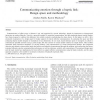Free Online Productivity Tools
i2Speak
i2Symbol
i2OCR
iTex2Img
iWeb2Print
iWeb2Shot
i2Type
iPdf2Split
iPdf2Merge
i2Bopomofo
i2Arabic
i2Style
i2Image
i2PDF
iLatex2Rtf
Sci2ools
IJMMS
2007
2007
Communicating emotion through a haptic link: Design space and methodology
Communication of affect across a distance is not well supported by current technology, despite its importance to interpersonal interaction in modern lifestyles. Touch is a powerful conduit for emotional connectedness, and thus mediating haptic (touch) displays have been proposed to address this deficiency; but suitable evaluative methodology has been elusive. In this paper, we offer a first, structured examination of a design space for haptic support of remote affective communication, by analyzing the space and then comparing haptic models designed to manipulate its key dimensions. In our study, dyads (intimate pairs or strangers) are asked to communicate specified emotions using a purely haptic link that consists of virtual models rendered on simple knobs. These models instantiate both interaction metaphors of varying intimacy, and representations of virtual interpersonal distance. Our integrated objective and subjective observations imply that emotion can indeed be communicated t...
| Added | 15 Dec 2010 |
| Updated | 15 Dec 2010 |
| Type | Journal |
| Year | 2007 |
| Where | IJMMS |
| Authors | Jocelyn Smith, Karon E. MacLean |
Comments (0)

